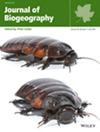Using a Nested Sampling Design Across Spatial Scales to Gain Insights Into Distribution Patterns of Fishes, Mussels and Macroinvertebrates in a Riverine System
Abstract
Aim
The goal of our study was to use a nested sampling design to compare the distribution of different groups of organisms with different dispersal modes and examine their responses in community composition to environmental heterogeneity at different spatial scales (local pool vs. riffle habitat, sections within a river and between rivers).
Location
Upper Colorado River basin, Texas, USA.
Taxon
Fishes, mussels and macroinvertebrates.
Methods
We sampled 100 sites using a nested sampling design across five rivers (four tributaries and the mainstem), with four river sections and five sampling sites per section, each consisting of a pool and riffle habitat. Collected data on species abundances, local and landscape environmental variables and spatial variables were analysed using a combination of dissimilarity, redundancy and variation partitioning analysis.
Results
At the river scale, environmental heterogeneity explained 28% and 34% of the variation in mussel and fish communities, respectively, and 15% for macroinvertebrates. Community changes between sections in the tributaries were highest for fishes, but similarly high for fishes and macroinvertebrates in the mainstem. Significant patterns for mussels were only detected in rivers with higher abundances. No significant differences in dissimilarity were found between mesohabitats, but a small significant effect of mesohabitat was detected for mussels with RDA after removing the river effect.
Main Conclusions
Although the depauperate mussel communities made it more difficult to draw any conclusions, there were some indications that their distribution was driven by environmental heterogeneity across scales. Section and river scales were relevant for fish, whereas macroinvertebrates showed a weaker response to environmental heterogeneity at these scales. The combination of approaches detected more ecologically meaningful patterns than one analysis alone would have. This study highlights the complexity of riverine community dynamics and underscores the need for a multiscale approach to identify their distribution patterns.


 求助内容:
求助内容: 应助结果提醒方式:
应助结果提醒方式:


